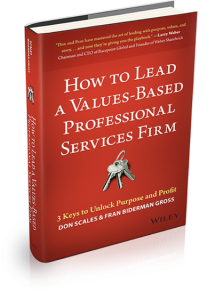
In this episode…
Don Scales is a master of M&A, he’s also a Purpose Champion— consistently driving businesses to profit through purpose and values. In this conversation, Don shares his insights on the importance of values in mergers and acquisitions, the subject of his newly released book.
Episode Transcript
Fran
Hi, I’m Fran Biderman-Gross, CEO of advantages an award-winning full service creative agency. And I’m here to discuss how the greatest leaders activate purpose. They uncover its roots, unlock its potential, and infuse it into everything they do to reimagine legacy, create winning cultures and achieve sustainable growth. listen in to learn insightful ways to overcome the real challenges countless leaders face every day.
Don Scales is the global CEO of Investis Digital, a veteran M&A strategist, a Harvard Business School grad, and a purpose champion. He drives profit with purpose better than anyone I know. Don and I co- authored How to Lead a Values-based Professional Services Firm together. Of all the successes that Don has had, and all the accolades and titles attached to his name, the one I like best is friend and mentor. Don has just authored his second book, The M&A Solution: A values-based approach to integrate companies, which will be published by Forbes Books this year (June 8, 2021). Don was kind enough to sit down with me to share a preview of the book, and his insights on the role values play in M&A.
This is really fun, because I get to interview you, and a book that you wrote, I want everybody to understand how the book came about.
The M&A Solution: A Values-based Approach to Integrate Companies
Don
Sure. When we wrote our book, it was a good book for me to write with you. Because it took me out of my comfort zone and had me thinking in areas that I hadn’t thought before. Then when I started looking at values and purpose, and those types of things, the thought came to me about how this could impact a lot of what I’ve seen over the years in mergers and acquisitions. The thought was, let’s see if this stuff could apply to acquisitions. I’ve had the opportunity to look at a lot of the literature on M&A. If you look at the literature on M&A, it really is all over the map. What you find is there are plenty of questions and not enough solutions. And the research is inconclusive. To me, it was a really important topic to write. Because when acquisitions fail, the first thing people blame are cultures and lack of alignment of values. And yet, there’s no discussion of that prior to the acquisition close. So the question is, why not? And what can be done about it. The whole idea of the book is to bring that thought to the forefront, and have people start thinking about it. Then towards the end of the book, we talk about some possible techniques that I’m working on that could help people during the pre-close phase of the acquisition.
Fran
To pull the first quote of the book, which really sets the stage for the entire book. It concisely captures and sets apart this book on M&A from everything else on the shelf. I want to dive into it a little bit, and I want to share it of course with all the listeners, which is: “The purpose of the book is to mitigate the culture clash risk. If you can reduce the risk, you can increase the odds of succeeding. It’s really just that simple.” Let’s unpack that a little bit. Because the odds of failing are incredibly great. Can we dive into that part first? Then let’s go back into the culture. If we eliminate the culture risk, because on the heels of book one, How to Lead a Values-based Professional Services Firm, there’s no question it’s about adding values on top of everything that David Maister wrote, which is kind of this Bible. Still very relevant today. But that was the missing piece. This is such a great continuation to put a microscope or a magnifying glass, if you will on M&A. Let’s unpack the first part, which is let’s talk about how many mergers and acquisitions actually fail and why are the statistics against you?
To fail or not to fail?
Don
Depending on the study, you can see everything from a low end of 50% to a high end of 90% or greater fail. Clearly, failure is in the eye of the beholder in some ways, but at the same time, the fact that 50% is probably on the low end, is kind of a stunning a number when you consider how much money is spent every year on acquisition. The fact of the matter is we do a very good job, an incredibly thorough job in the industry of looking at the other person’s business on the quantitative basis. But we don’t ever step back and say, does this acquisition really align with the way I do business or with the way this company does business? Does it make sense to go forward? That’s what really prompted this book. You can go to the M&A shelf in a bookstore and see so many books that talk about due diligence checklist and various things and these checklists go on and on. You would think that, if I really took the time to fill out the checklist, I would have a very high percentage of success. If I do all that work, then I should know all my problems, yet you don’t. The question is, why, and what can be done about it.
And so that is what got the book going. Like I said, there’s a growing amount of literature research in the M&A field and, and some very interesting stuff, but it literally is all over the map. One thing, that’s not taken into account either, and I don’t talk about it a lot in my book, probably a topic for another book, is integration and the impact the whole integration side of things has on the ultimate performance too. And, that’s yet another topic.
Fran
You’re hitting the sweet spot when we talk about bringing values to life and having them woven inside the fabric in the company. That’s really what you get at, because to pull from the book, “The failure rate doesn’t prove that M&A is in and of themselves are prone to failure. It simply proves that badly conceived and executed M&A are prone to failure.” The reason they fail is because they actually overlook the most important part that needs to be woven and integrated, the people and their belief systems. So that Company A and Company B together are exponentially better, they have to understand why they’re coming together.
Don
What you find in the literature that I think is really valuable is that when most people think about M&A they think about it along one dimension. Or they want to examine one dimension of the process. But mergers and acquisitions are a multi-dimensional. It’s not just one thing that makes it a success or failure. It is the interplay between a number of different things that are going to create that, and that’s where values comes in. Because values really overlay everything. If you don’t have a good view on your values and how they are going to play, then you’re going to miss some things. I think that’s the hole out there in the work that I’ve seen.
Fran
Your leading right where I want to go. You’ve said many times that the trick is finding a company whose values are just different enough to enhance your company’s, but not so different, that integration is impossible. Talk to me about fit because I think that is key to understanding. Taking the time to understand a how your own company values show up. Are you cognizant and completely aware of the differences and the similarities? So that there is an enhancement. I think that is a really interesting observation. I bet you have a story or two that even demonstrates you know, what a good fit in a merger or an acquisition is.
M&A Done Right
Don
I probably have better stories about ones that aren’t good fits, but we’ll get to that. One of the things to your first point, you want the value sets, it’s not that they have to be properly aligned, I mean, it doesn’t have to be identically aligned, or in some ways, it doesn’t even have to be that close. But what you have to understand is the differences in the value sets. So you can plan, there’s a whole lot of integration planning that must go on. For instance, if the values are clearly aligned, and the companies view things the same way, operate the same way, then what you’re going to see is, you can do a much more fully integrated solution, you can put things together in a lot quicker way, you can bring these companies together, and you stand a much higher percentage of success, because those values are aligned, and people are going to work together and collaborate. If the values aren’t aligned, you may either decide to keep the companies separate from each other and almost operate in a holding company way of fashion. Or you may really slow the whole integration and not let it take place for quite some time until you can change out some parts, maybe make some changes and get the integration going your way. So regardless, you can make them work, but you must have a clear understanding about what you’re getting into, before you can really plan how you’re going to put it together.
Fran
It’s very clear advice from someone who has done this so many times and will continue to do this. But there’s really an art to this, this understanding to come to this clear understanding. And I think that really separates you. This is a skill you have honed for some time and through a number of failed and successful mergers and acquisitions. And I have no doubt that there are so many learnings from each one on both sides of the coin. But I think about how can we share the experience over time? Can we talk about whether it’s the investors or across icrossing? Or any of them? Could you give us some concrete examples? So that it’s, it’s truly clear to the listener, what you’re trying to explain.
The Importance of Shared Values
Don
iCrossing is a good example, because we did about seven acquisitions in about a span of three or four years. One of the best ones we did was, we really wanted to be international in scope, so we decided we were going to look at a company in the UK and Brighton. They were going through a sale process; they had engaged a banker and we came in somewhat late to the party. There was a lot of competition there. The way we got their attention wasn’t that we tried to catch up and just jump in there with a bid and those types of things. What we did was – we said, “Well, before we get going, I want to make sure that the CEOs are compatible and get along.” So I suggested that the CEO of iCrossing and the CEO of this company in Brighton, get together and go to dinner. They ended up spending a day together in Paris. And they ended up talking. There was just so much overlap in the way they started their businesses. They’re both founders, and founders have this unique way of thinking about life. And so they were both founders, they’d started a business, they gone through the same kind of problems, they’d grown and done a great job. And they both have mutual respect for each other. When they came back, there was a certain amount of enthusiasm and momentum. They were both somewhat aligned in what they wanted. And then when we started talking about, well, what if we put them together and you found out that the founder on the other side was not interested in leaving, he wanted to continue to grow the business. And, you know, his ambition was to keep the company, stay at the helm and continue to grow the company and those types of things. It made it a much easier process because there was some enthusiasm around the whole thing. Now as a result of that, that was a highly successful acquisition for iCrossing. It was our first international acquisition and was probably one of the best just because I thought that we planned it out from day one and we took into account all the values related stuff that you and I are talking about here.
Fran
I think is really important to highlight that people buy things from people. If people don’t identify and find a way to emotionally connect on the values that they share, even though they’re different, you won’t have a greater success or probability of success. That emotional connection is going to be the passion that drives the intention through. Every leader needs to stand up and say, “We’re going here. And we’re passionate about going here.” If they’re clear, and they demonstrate unity, one plus one is greater than two. They’re going to have a much easier time integrating and bringing people together. That’s a lot of what I take away from the meeting in Paris.
Don
That’s exactly right. We had another one that we looked at, that we actually walked away from. I had a meeting with the CEO of this company, it was another British company, they had a lady CEO, and she came to Phoenix, and she met CEO of our company, and I sat in on the first breakfast. You could tell in the first five minutes, that there was just no chemistry there, there was no interest, it was a lot of distress. And even though she wanted to sell, and he kind of wanted to buy. I ultimately got in the middle and said, I don’t think this is going to work because for just the opposite reasons why the other one worked. I think those are very important considerations upfront.
Fran
If you take away nothing else from this conversation, it’s that there has to be alignment. It’s not about the numbers. First, it’s about the people. First, it’s about identifying the things that you value, and making sure that there are a whole bunch of checkpoints on that side of the checklist that that hasn’t been created yet, that really focuses on the values to be able to understand their compatibility. And it starts with this emotional connection. Which is really the incredibly important lesson that I hope everyone takes away and really goes to read the book. There’s so much in it, that demonstrates your thought process if you’re thinking about M&A, if you’re thinking about selling your company or merging with another, there are things in here that will help you put a different light on how you prepare yourself for the conversation. It’s really almost a map for helping understand M&A through a completely different lens, which has been incredibly helpful. It doesn’t hurt that I understand it so well from the values perspective. It is a very thoughtful journey with a lot of very visual storytelling examples that make it so easy to understand and all the things that you could potentially miss. This will give you a great shot at not missing them. I want to go back to iCrossing and talk a little bit about what success and failure could potentially look like even a decade later. There are some really great lessons in the iCrossing mergers that were so wildly successful inside of those seven mergers. And yet, the last one, do you deem that a success?
Don
When we were bought by Hearst in 2010. That was probably one of the larger agency related acquisitions of the year. It got a lot of play just because who the buyer was, Hearst was built over the years on buying a lot of different companies, principally publishing companies. Which is a big, big distinction between that and what an eye crossing was, which is in the performance media space. But I think what happened was that there was trust that were built during the process that were not lived up to over the course of time. And as a result of that they’re just they built walls up between the parties, because one could not be assured that they were going to trust the other. And ultimately, it takes a while for these things to play themselves through. I left three years later. Even now they’ve been through four more CEOs since I left. Today, they’re announcing that they’re giving separation agreements sell the rest of the employees. What was one of the world’s best performance media companies is now an afterthought? I mean, it literally is a case study on all the things that can go wrong.
Fran
Well, I think, important case studies that don’t necessarily work out to great success are they’re incredible lessons to be learned from them. And just knowing how you were on the, on the right side of the table when that all started. And yet, it probably pains you on so many levels, that it was a great idea to what could be and and how that it didn’t become.
Don
One thing I would like to add, I think it’s very important. It goes to show, in this particular case, how a lot of times acquisitions are viewed based upon their strategic fit, and how one is going to impact the strategy and the bigger picture of where the company is going to take it. In this case, this was a publisher who wanted to get in the digital space. In concept that made a good amount of sense. They chose well, they picked a great company. It goes to show that if you don’t have the execution on the back end, the integration on the back end, that really strategic fit means nothing in the end, because you probably won’t have much of an asset left. I think that’s supported in the literature as well, when you’re when you read about this stuff, you read that strategic finance only good basically to you till you close the deal. And from then on, it’s all in the execution.
Fran
I want to talk about your definition of how values drive a company because I state: “Values and culture can cover a lot more than you think. They’re not squishy pie in the sky concepts. They are observable and measurable, if you know what you’re looking for. And at this point, I should probably back up and explain what I mean, when I talk about values. My definition, a company’s values are how it runs its business.” I think this is a really important lesson that we should unpack here, because there’s so much value in your definition. I’m curious, how did you come to articulate that? And what do you mean by it,
Values=How you run your business
Don
That saying that about our values is how you run your businesses, in some ways, is kind of intuitive and obvious. Because you are, what your values are. You’re going to run it the way that seems comfortable. And is consistent with the way you’ve sort of grown up in the business world and how what you’re used to so. You can look at the focus. Is the focus on people? Is the focus on customers? At the top you can learn a lot from just the way they operate the business. I think that part of it is something that you just need to understand – who you are what you are, and that includes your values. You need to go back and explore what you are to make sure you really understand it. Very few people do this to be honest with you. I think I learned this from you. I mean, I know I’ve always said that when I grew up. I mean I in the business world, the last time I saw a set of values it was framed in a boardroom somewhere and that was the last time anybody said anything about it. Yet after working with you guys and helping to rebrand Investis then it became much more of a living, breathing kind of thing for us. Now it’s just part of the vernacular around the company. I think we’ve grown a lot in that regard. I think that’s exactly what I mean by in the book there.
Fran
So thank you for that. And it was absolutely my pleasure and my honor to work with such an incredible team, who truly was able to embrace the articulation that we really came to. We could talk about how in every direction you talk about, whether it be culture and in team building, where we talk about sales, and we talk about performance and the pitches, whether we talk about the brand rollout that was a, you know, huge responsibility to take two companies and shift a perspective and not lose a single client because you were so clear, and it was clear To all your clients, it was clear to all your stakeholders, it was clear to all your employees that you had a bigger vision of where Investis was going to go. It was synthesized and executed and embraced beautifully by your leadership team. To this day it truly acts as a decision-making filter for how you decide to build new products, how you decide to open up in a new location, and how you actually measure people’s your own team’s performance. It’s such a synthesis, this integration that has become such a natural place that has only proven the true success of Investis. And I know that you have some great news to share about Investis, as well, which of course started with, you know, the planning of these great next steps. You want to share?
Don
Oh, if you’re talking about our new partnership with Investcorp, is that what you talking about? So we had a good partner for a number of years when I first came on board, our major shareholder was a company called ECI based out of London. It was a mid-tier private equity firm, great, great people. I enjoyed working with them a lot. But you know, at some point, people need to make an exit. And we also needed somebody who had the resources to carry us to the next level. We found Investcorp. Investcorp came in and has been a great partner. So far we’re just getting to know each other. But I’m very excited about the potential. I think what they realize, and it’s really important, is that we’re just beginning a journey of where we want to go as a company, and we can articulate where we want to go. But it is just beginning and once Investcorp saw that they saw the potential for what we want to grow into. Then they wanted to be in the passenger seat next to us. So that was one that’s really exciting. And I look forward to a number of years working with them in the future.
Fran
How did you get to Investcorp? Like you spent a couple of months going through the phase?
Don
The process was a typical banker led process, where do you go out to the world with the idea that you’re on the market, everybody comes around and kicks the tires, if you will, to a certain degree to understand what you’re all about, a certain number of them get excited about it, and they put in initial offers, and then you pare that down to something a little tighter, and then you pare that down to you know, an exclusive one, and then you go through and then do that. Part of that process for me was, as you got further down the process, and say you got it to the last three or four that’s when the responsibilities on the management team kick in. You really have to go spend time with these private equity firms or whoever the investors are, to make sure that you’re going to be in good hands, because that’s who you’re going to be spending the next three or four years of your life with or whatever the period is. If you make the wrong decision there, if you just pick on the basis of the highest price – you can’t be the lowest price, you got to be close to those price – then I think you could get in trouble if you don’t spend enough time. I think ECI, our former investor, did a really good job. They got it down to a couple people that they were okay with his regarding the bids, and then they basically said go pick who you want. And so they let the management team go do the rest. And I think that led to a good result.
Fran
I have no doubt you had many lunches, coffees, dinners, drinks, getting to know a fair amount of them. It takes a lot of that, that’s for sure. So what was special about this partner,
Put in the time, do the research
Don
First of all, they put in the work. There’s a lot of people, when they look at your company, they want to tell you the three or four deals that they did that somewhat looks like your deal. Or they think it’s in the same space, when it really isn’t. But when it demands time, that they invest to go really understand your business and dig into your business. They’re not willing to do that because they have three or four other deals they need to be looking at. You get a certain percentage of time and that’s it. These guys understood our business from the first few minutes. But even more importantly, from the first meeting, they started digging into the data and understanding the data and asking questions. By the time we got to the end, they knew as much about our businesses we do. It makes for a much better conversation now, from a working relationship standpoint, because we’re not bringing people up to speed, we’re having constructive conversations about strategy and where we want to take it, about mergers and acquisitions, those types of things. They’ve put in the time, and I appreciated that a lot. At the end of the day, in these situations, the management team is key to the success of this. If you’re buying a company, and you don’t have the management team committed to what they’re doing, then you’re probably looking at the wrong company.
Fran
They certainly did everything right. I recall just a few days after the deal was sort of inked, you’re off to complete or make an offer on another company. That how quickly, they were so much aligned from the get-go, that you’re able to already begin, within the first few weeks, to explore, and to set on that path. I do want to talk about a little bit at the end of the book, because you start to reveal, after all that you’ve learned, then after all of these checklists, and all of this research that you have done and lived through, I think it’s really interesting how you end the book, as you actually pique our interest into what might be coming next. So can you share a little bit without being a good spoiler alert for any good ending of a book? But can you share a little bit about the end of the book,
Don
My premise, as I said, at the beginning of this interview, as well as in the book, is that I think there’s a void in the marketplace and understanding values. First of all, there’s a void in most companies and understanding what your own values are, but even more importantly, what the potential compatibility of your values was someone else’s. I’ve been giving some thought to how you could sort of quantify a very qualitative kind of topic. In the pre-close phase of an acquisition, take a look at values for both parties and come up with a measurement that will give you some thoughts around whether or not this is a compatible acquisition. My premise is, I think you can quantify this. To a certain degree, I’d like to do it because I can tell you if we can come up with this measure that I think would make some sense, and it’s something that I could use in my everyday business, I’m sure it will be useful to other people as well.
Fran
I certainly look forward to continuing that work with you. And watching that develop and quantify. Is there anything that had surprised you in any of the mergers in your repertoire that we could share?
Things don’t always go according to plan
Don
First of all, these processes are not just in straight lines. They kind of go all over the place during the course. But the first acquisition that we did at iCrossing, goes back to my point about strategic fit. This was a really transformative acquisition for us. It had all the markings of a great acquisition, and it added a whole new product line under what we were doing. We were very excited about it since it was the first one, we had to go through extra care with our board to make sure that we had justified it and done all the numbers and had all the integration plans. On our side we felt like we were buttoned up as we possibly could be on this thing. We got the deal done, we were all excited and we’re going to go visit them. On the first day we were going to meet the whole team and these guys were in Sausalito, California. We go over to California from Arizona and we show up at their building and the CEO meets us at the front door and welcomes us. We felt like it is the conquering kings kind of thing. We thought we were just really in great shape. We walk in, and we’re talking to him about all these integration plans we had. And I said, and now we got to talk to whoever is the leader of integration effort. I’m sure your people know about this, know about that. He says, Oh, yeah. We get in there and there’s about 75 people in this conference area, and we’re going to have a presentation.
So the introduction, the president gets up and CEO gets up. And he says, I just want to tell you guys, a couple things that you probably don’t know. He says, for the last six months, I’ve been trying to sell the company. He said, I have managed to do so. And these two gentlemen, right here, represent your new owners. And today will be my last day. And I appreciate the opportunity to work with you guys for the last 10 years. And I wish you all the best. And he just walked out the side door right out the fire escape didn’t go out the front door, went right out the fire escape. And that’s the last we saw. So I’m standing there with Jeff, and we’re saying, holy cow, what are we going to say to these guys. We had no idea that they knew nothing. And we’re standing there and we’re all buttoned up, we thought. Fortunately, there was one guy who had used to work for me at a prior company. He said, “Hey, Don it’s good to see you. It’s gonna be great to work with you.” And that sort of broke the ice. We started to spend the next few hours explaining our company and how it was going to work together and how that all kind of turned out in the end. There was about a good hour in there where there were the most awkward moments that you could possibly imagine. It just never works out like you plan.
Fran
There’s definitely a lesson of the surprise element and how elegantly you can turn things around. But I have no doubt that that hour of awkward silence is one you will never forget. I always remember that story. Well, I’m sure the listeners are going to take away at least a nugget from now on what their intentions are in terms of integration before they actually let someone off the hook. I’m sure that never happened to you again. There you go. Lesson learned.
Don, this was really fun. Thank you. If you’re a leader, or aspiring leader, absorb all the experiences and insights you can subscribe to this podcast right now to uncover the purpose driven world we live in to unlock purpose and profit.
This episode is produced by…
This episode is produced by Advantages, an award-winning branding and marketing agency that turns buyers into believers. They have worked with companies as far reaching as the new terminal one at JFK airport, as well-known as Jay Z, and as fun as NFL football teams, along with some of the world’s most impactful nonprofits and aspirational mid-sized businesses.
Advantages uncovers the meaning within brands and infuses it into experiences—purposeful branding, engaging events, and strategic marketing.
Explore how this agency can help infuse purpose into your brand so that you connect with the audiences that matter most to you.









 For more than three decades, Don Scales has run professional services firms and understands firsthand how to make them succeed. In his current role of global CEO of Investis Digital, he is executing on his vision to lead a company unlike anything else in the digital communications space. He’s put together a team with deep expertise in corporate communications and investor relations and united them with innovative performance marketing experts and world-class technology solutions to help companies connect with audiences across all digital touchpoints.
For more than three decades, Don Scales has run professional services firms and understands firsthand how to make them succeed. In his current role of global CEO of Investis Digital, he is executing on his vision to lead a company unlike anything else in the digital communications space. He’s put together a team with deep expertise in corporate communications and investor relations and united them with innovative performance marketing experts and world-class technology solutions to help companies connect with audiences across all digital touchpoints.
